
|   |

|   |
 e-mail: sunilkothari1933@gmail.com Silver Jubilee of Guru Pankaj Charan Das Utsav and Centenary celebrations of Pankaj Charan Das: Part I Photos courtesy: Sarat Das April 3, 2019 In memory of Pankaj Charan Das, Adi Guru of Odissi, his son Sarat Das and Guru Pankaj Charan Odissi Foundation in collaboration with Govt. of Odisha, GKCM Odissi Research Centre organized a five day dance festival at Rabindra Mandap, Bhubaneswar from 17th till 21st March. 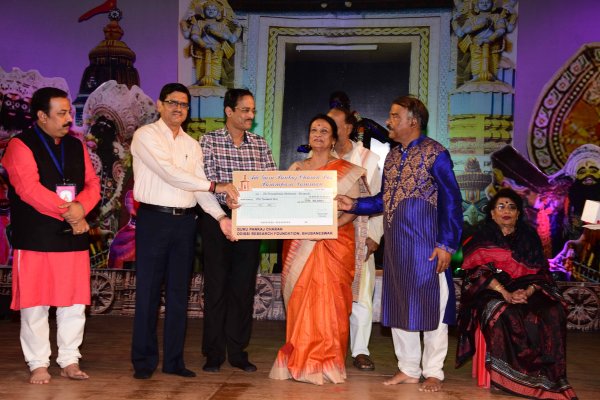 Priyambada Mohanty Hejmadi 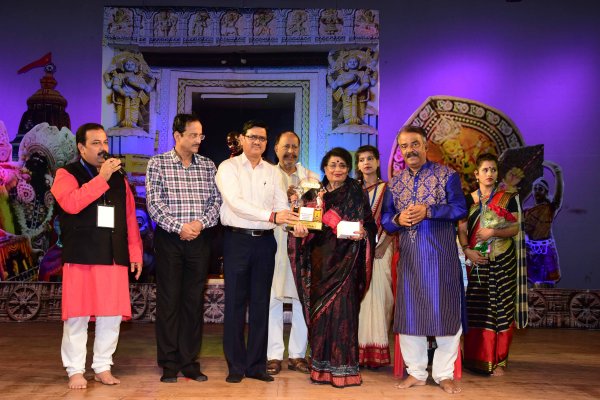 Minati Mishra On this occasion, Nalco organization presented Adi Guru Pankaj Charan Das Parampara Sanman 2019 to two legendary dancers Minati Mishra and Priyambada Mohanty Hejmadi. Manoranjan Panigrahi, Principal Secretary, Dept of Culture and Ashok Kumar Tripathy, Former Member of Board of Revenue and other dignitaries honoured the dancers. Minati Mishra recalled Guruji's services as a pioneer guru and paid tribute to him as he had taught at Utkal Sangeet Mahavidyalaya, when she was Principal. Priyambada reminisced about how she was dressed for her very first appearance in Odissi dance in intercollegiate competition in 1954, when Odissi was introduced as a dance form. "Guru Pankaj Charan Das' wife Sarojini Devi from the Mahari family (and the daughter of the legendary Mahari Haripriya), taught me the wrapping in Mahari style in 1955 for the All India Dance Festival where we staged the Sakhi Gopal dance drama written by Kabichandra Kalicharan Patnaik, choreography by Gurus Pankaj Charan Das and Kelucharan Mohapatra. Music by Balakrishna Das really elevated it to a masterpiece. She even brought two mahari kanchalas, one in velvet and the other in Benares pata (silk). I still have them in my collection - real sacred and precious as they were worn by Maharis during their rituals in the temple. For the first Inter-University Youth Festival, I was dressed in Gotipua style!" . She also recalled that SNA has an interview in form of Q and A where major historical facts of Odissi dance are recorded and Guru Pankaj Charan Das's dance is also recorded. GKCM Odissi Research Centre has also recorded Guruji's dance in an extensive interview. Disciple of Guru Harekrushna Behera, a young dancer Prachi Hota screened a brief documentary film outlining Guru Pankaj Charan Das's life which includes how Lakshmipriya, wife of Guru Kelucharan Mohapatra was taught abhinaya. She played the role of Mohini and Pankaj Charan Das that of Bhasmasura. Kelucharan Mohapatra was employed for playing mardala. He and Lakshmipriya were taught a dance item of Dashavatara, which they performed at Annapurna Theatre B group. These are important landmarks in the history of Odissi dance. Within a short span of 70 years, Odissi has become a part of international dance scene. The film captures the trials and troubles of the guru as he had to sell paan and supari, work as a labourer to support himself. But when his talent was discovered that he could act and direct he was engaged at Annapurna B Theatre, this was the time when Kavi Chandra Kalicharan Patnaik was foremost playwright and the theatre movement was gaining popularity. Guruji later on started teaching dance and the rest is history. Manoranjan Panigrahi announced that such documentaries and interviews will form part of online digital history of Odisha for future generation, a project which Govt has undertaken. The performances were divided into two presentations: from 4 to 6pm by young dancers and from 6.30 to 9.30pm by senior dancers. Day one On the opening day prior to Parampara Sanman ceremony, six young dancers gave brief performances. Shriya Chakravarty presented Sabhinaya Pallavi in Kalyani raga Dekhi mu para asha re describing the beauty of Krishna. It was choreographed by Sarat Das as learnt from Guru Pankaj Charan Das. There was a certain naiveté and innocence in her exposition. The sensuous aspect of Odissi movements sit well on her frame. These are oft performed items and are a part of Odissi repertoire and carry usual familiar images. Saswat Joshi's disciple Somnath Datta presented a lyric Rasapanchaka of Bhanja Dev choreographed by Guru Pankaj Charan Das and later on as Sarat Das studied it. He has trained many dancers in this rare pada of Bhanja Dev. It was first performed by Guru Gangadhar Pradhan. Each word represents something. Ra for description of a nayika, Sa for Sharira, body of the nayika, Pa for payodhara, the breath, Cha for chibuka, the tip of lower face, and Ka for kati, waist. The description was interspersed with ukutas, mnemonic syllables. Guru Pankaj Charan Das’s use of ukutas when lyric mentioned playing on mardala were excellent, so was the description of beautiful damsel with her dhammila, hairdo, her gait like swan, the embrace with the Lord, Krishna's gait as elephant; the maiden's agony being attacked by the arrows of Kamadeva highlighted the lyric Rasamanj ke ramanivara. I saw this lyric danced for the first time, and could see how Guruji has invested the form with grace and beauty. Suchismita Kanjilal selected Ahe nila shaila janano of Muslim poet Salabeg. Disciple of Paushali Chatterjee, she followed Kelubabu's style. However, the exaggerated abhinaya of Shakuni throwing dice and his attahasya, somehow looked over the top. Certain restraint needs to be exercised to avoid overacting. Bangalore based Yashomati Mishra's prayer on Mahakali choreographed by Bichitrananda Swain was in part well enacted. To bring out characteristics of Goddess Kali in her gentle and demonic aspects were understood well by the dancer. But she brought in too many elements and shlokas of Narayani Namostute which did not balance the entire presentation; it could have been edited. Amrut Jagan in Bharatanatyam presented Yahi Madhava khandita nayika weaving in Radha's unhappiness at Krishna's playing truant and returning in early house of the dawn. Her abhinaya to the stanzas taunting Krishna ended with 'nirdaya balacharitam', killing of Puthana. It looked rather abrupt. K. Jyotirmayee's Ardhanarishwara choreographed by Kelubabu was full of vigour for Shiva's description and full of lasya for description of Parvati. She performed with certain agility and quick movements which suited her well. There is a specific alertness on her part and also a sense of graceful slowness, which made this item interesting. 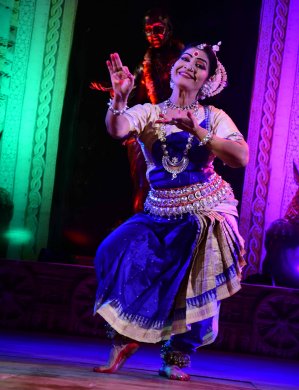 Suhag Nalini Das  Saji Menon In the second part when senior dancers performed, Pankaj Charan Das's daughter-in-law Suhag Nalini Das paid tribute to her guru with Madhurashtakam, choreographed by her husband Sarat Das. It was a favourite item of Pankaj Charan Das. Guruji seemed to have laid emphasis in the beginning on childhood pranks of Krishna, motherly love, where all his acts are full of madhurya, endearing. In Gopi madhura gau, cows, madhura, the gopi's gait, and grazing cows were quickly suggested; the enactment of Holi, the use of khol as used in Bengali padavali brought in whiff of fresh air, looked rich and melodious. The sanchari of subjugating Kaliya and dancing on his hood offered glimpse for devotees as 'Madhura' was all encompassing for divine act of the god. Madhurashtakam invariably succeeds in its canvass. In particular the singing was melodious and pervaded the entire dance with madhurya, sweetness. From Mumbai, Mohiniattam dancer Saji Menon, a disciple of Dr. Kanak Rele, presented the story of Ambalika who returns in her next birth as Shikhandi and stands before Bhishma to take revenge. Arjuna then shoots arrows as Bhishma refuses to fight when Shikhandi stands before him, to the music by Kavalam Panicker and abhinaya as taught by Kanak Rele. Saji did justice to this item which has been of late often performed by disciples of Kanak Rele. Saji has a mobile visage and she registers bhavas well, her movements are quicksilver. From Delhi, daughter and disciple of Guru Harekrushna Behera, seasoned dancer Kavita Dwibedi selected Banamali's song depicting both abhisarika and khandita nayika. The song is parallel to Gita Govinda ashtapadi Yahi Madhava. Kavita registered expressions of disappointment, accusing Krishna for his infidelity, making her wait, and arriving late after dallying with other gopis, telling him how she stealthily moved in dark night to meet him, overcoming obstacles, like serpent crossing her path, her sari getting entangled in a thorn, and arriving did not find Krishna. All her expectations had turned into disappointment. As a continuity of the performance, Kavita as Krishna enacted ashtapadi Priye Charushile begging Radha's forgiveness and when Krishna begged her to place her lotus feet Dehi pada pallavamudaram on his head, Radha fell at Krishna's feet in reconciliation. Except at one moment when Krishna tells Radha that she is his life, the music was too loud. It did not gel well with the mood. The musicians gave her adequate support. 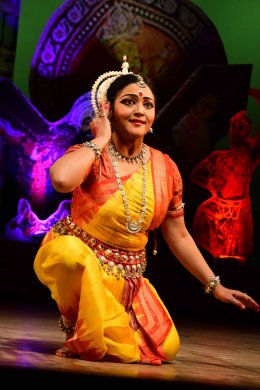 Kavita Dwibedi 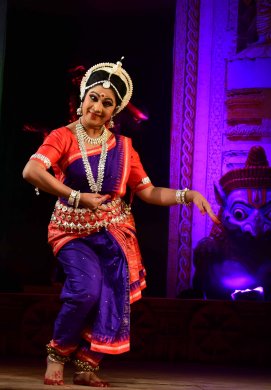 Shubhada Varadkar From Mumbai, Odissi dancer Shubhada Varadkar, disciple of Kelubabu, selected lovely pada describing the beauty of Radha dancing with Krishna. Aha ki sundar dishe Radhika rani Murali Pani, Krishna in tribhanga, the waistband with gentle sounds of silver bells, the ankle bells on feet dance in unison, the poet at a loss on how to describe the beauty of divine pair dancing together. They play Holi in abandon and the use of mnemonic syllables adds to the joy of playing Holi. It is a gem of a lyric and was danced joyously by Shubhada, who has attractive stage presence and pulled off the item with charm. The connecting pallavi was rather loose and looked weak in nritta, whereas Shivoham dwelling upon the philosophy, 'I am not death or life, nor good deed or sin, neither bondage nor freedom, but am pure bliss and Chidananda' was conveyed well through contrasting elements.
Glani Sanghara group dance choreographed by Pankaj Charan Das remains in memory as one of his best choreographic works. Guru Bijay Kumar Sahu's Nakshatra Gurukul presented it with live music, reminding seniors in audience of the imaginative choreography of Pankaj Charan Das. It is in essence, story of ten incarnations, but in treatment it is original in concept and groupings, use of space and formations. Stories abound whether it is Matsya, the group dancing with matsya hand gesture, with Kurma, dramatic ways Hiranyakashipu is killed by Narasimha, and Parashurama annihilating kshatriyas, Balarama channelizes Yamuna. Ravana being killed by Rama, weaving anecdote of golden deer, Buddha renouncing the world and taking to sanyas after watching four stages of life including final death, and so on were choreographed imaginatively. With Kalki, Krishna's assuring devotees that he shall be born again and again, Sambhavami Yuge Yuge when there prevails sin in world, Glanir bhavati conveys the message succinctly. The dancers performed with involvement. It was important to revisit Guru Pankaj Charan Das's excellent work for many in the audience had not seen it in recent times. Day two The second day's celebrations included in the first half, five female dancers and one male dancer. Not all had even standard, since they all had training under different gurus. The intent was to showcase young talent who have shown promise. From Mumbai, Shreya Sabharwal, a disciple of Mahari awardee Shubhada Varadkar opened the evening with a Pallavi set to Janasammohini raga composed by Vijay Tambe. Shreya has good stage presence and her movements have certain fluidity, moving from one to another in an easy manner. However, the quality of Odissi as it has developed in Mumbai by Guru Kelucharan Mohapatra's students differs from what one watches in Odisha. Odisha based dancers have certain gravitas in their technique, but that gravitas is not seen in Mumbai based dancers' young disciples. This is bound to happen in terms of regional variation over the years. In expressional number, Shivapanchakshara with Nagendraharaya describing Lord Shiva adorned with serpents as his garland, Shreya described other epithets replete with devotion. The suggestive references to Nilakantha and Digambara were performed dramatically. A young dancer Bibhu Dutta chose to perform Nachanti sange shri Hari choreographed by Kelucharan Mohapatra. The entire pada displays various ways in which Krishna performs. What Guruji has woven in the choreography is several ukutas, using various patterns of mardala. It gave Bibhu Dutta chance to perform dance in various ways reflecting Krishna's dance with its divine beauty. Wherever mardala was referred to in the lyric, the movements of mardala and parshva mardala was executed. The various instruments and attractive poses of Krishna's dance were executed well. His chowka position was clear but he needs more practice for maintaining balance for final poses. There appears effort in performing, which should look effortless. That would come with more practice and exposure. What also did not go visually well with him was his beard. In case of a Sikh dancer like Bharatanatyam exponent Navtej Johar, his art transcends his bearded appearance. Bibhu Dutta would do well to maintain an image of Krishna dancing minus the fashionable beard. Bangalore based Banshee Mohapatra in abhinaya item of Banamali's song Baju chhi bajare brought to light the clandestine love between Krishna and Radha. The sakhi tells Radha not to display her love so openly. 'People know why you go on terrace and spread your hair and from below, Krishna walking by signals you, and O friend you think people do not notice or make out your intentions?' Banamali's song is a popular number with young dancers. It gives scope to them to express affectionate expressions and display the joyous love between the couple. Meera Das's student Bidya Biswajita from Cuttack performed to live music in Jhinjhoti raga a song dwelling upon the love of maidens of Braj for Krishna. An expert in playing flute whether under the tree or elsewhere, Krishna chooses the flower and places in the hair of the gopi, Krishna's tribhangi pose, Krishna's Kaliya Daman pose and his killing of Bakasura enacted suggestively. Sabita Mishra from Mumbai, trained in Guru Debaprasad style, performed Gopi's fascination for looking at Krishna in Chahi go O sahi song of Banamali. With her attractive face and large eyes, with less movements, she often stopped in her track at Krishna's vision. Sabita managed to express with subtle movements of the eyes, Krishna signaling her and she getting completely overwhelmed. The haunting refrain of Chahi go Mohan ku was rendered in melodious tune. In the very opening sequence while placing the pot to fill with water in river Jamuna listening to the flute, Gopi looks up and sees Mohan, one who enchants and the mood was set. Of the two disappointing presentations, one was by Sasmita Pal, disciple of Gajendra Panda, who performed Shivashtakam in Bhairavi. Vande Shambhum, Umapatim, Pannagabhushanam set the tone for dance of Shiva. But Sasmita lacks saushthava, correct body position. Using Sabdaswarapata, a special feature of Guru Debaprasad Das and Gajendra Panda, she overdid using too many elements showing tandava aspect. Not her fault if the choreography was set accordingly. It needs editing to sustain interest. Rojaleen Mohapatra, comparatively a senior dancer performed to songs of Meera and wove in various episodes. She too should have edited the episodes and made the item brief. In the post interval period during the main evening performances, the first was by Aruna Mohanty. Known for extending the boundaries of Odissi both in terms of thematic content and collaboration with other choreographers of different classical dance forms and mega productions, Aruna has created her own niche, winning laurels. To wit, her choreographic works to the librettos of the poet, lyricist Kedar Mishra like Nayak and Pratinayak and one she presented in the evening Bhumisuta, are excellent examples as solo numbers. 'I am the daughter of the soil, Bhumisuta, Rajanandini Janaki. Today, when my mother, earth has torn her bosom to take me into it - I remember my birth from the sacred soil, my marriage to Lord Rama, my unconditional love for my husband, humiliation I suffer after my abduction by Dasanana, and my husband's questioning me to prove my purity? But my womanhood cannot be subjected to such disgraceful condition! Hey mother!, let me take my final rest in your bosom....' With soliloquy in Odiya, Mu Bhumisuta Janakarajanandini,Yagnakundar matir mo janma, Sita recalls how she has loved Lord Rama, manasa vachasa karmani (Sanskrit Valmiki). The story unfolds how Rama lifted the bow of Lord Shiva, married Sita, arrived in Ayodhya where celebrations took place, but alas! before the crown was placed on Rama's head he was banished for 14 years to forest and Sita followed him: Jiya binu deha, Nadi binu wari, aise hi Nath Purush binu nari, Nath sakal such saath tumhare, Sharada vadan bihu naina nihare - like without body there cannot be soul, without water there cannot be river, similarly without husband there cannot be woman, all happiness is with you O Lord, my eyes shall watch your face shining in Sharada season.' (Tulasidas) Using such exquisite lyrics along with his own lyrics, Kedar Mishra has conceived an engaging script. Aruna has taken a challenge to tell a khyata kathavastu, well known story in her own inimitable manner. In quick succession the story unfolds -chasing golden deer, Rama leaves Sita, Lakshmana draws three rekhas which Sita was not supposed to cross, and Ravana comes in disguise as a mendicant, kidnaps Sita flying away in his chariot. Aruna with her ability to dramatize these sequences in nutshell carried forward the narrative. After vanquishing Ravana, bringing Sita back to Ayodhya, the calamity struck when a washer woman taunted her husband when he accused her of seeing another man, when she had gone to her parents. The Odiya rendering by washer woman: Rani kar dosha, nuhit dosha, ami sabu kare, kale mahatta (the queen returns after living with a man in exile is not a big blemish and my visiting and staying with my parents is a blemish). The rumours reach Lord Rama who is pained and requests Lakshmana to banish Sita to forest even when she is pregnant. Sita leaves Ayodhya. She does not lose her womanly pride. She returns to Madhavi, her mother. The finale is most effective. Aruna falls on the floor and raises her arm releasing the fist full of earth which like shower of rain falls on her body. She merges with mother earth. Aruna has created a memorable work, based on well-known epic Ramayana, which one is familiar with. What is remarkable is her individual approach and collaboration with Kedar Mishra. With a team of competent musicians the choreographed work stands out for its individuality. Credits are: Music composition by Rupak Kumar Parida and Guru Bijaya Kumar Barik, mardala by Bijay Kumar Barik, vocal by Rupak Kumar Parida, violin by Ramesh Chandra Jena, and flute by Soumya Ranjan Joshi. Lighting was by Debiprasad Mishra. 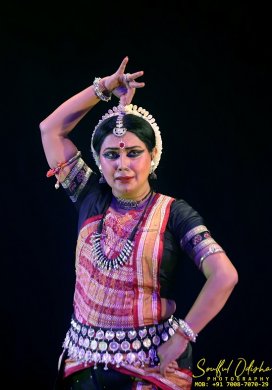 Aruna Mohanty  Aloka Kanungo Aruna's performance was followed by Aloka Kanungo, the celebrated Odissi exponent, disciple of Guru Kelucharan Mohapatra. She is a seasoned dancer. Petite and with expressive face, with her young maiden like charm, over the years Aloka has won over her audiences with her delectable performances. The Bilhari Pallavi is another gem of choreographic and musical composition of Kelubabu and Bhubaneswar Mishra. One never tires of watching the Pallavis created by these two stalwarts, especially when performed by an ace dancer. Aloka went through the paces with aplomb creating beautiful images. The ashtapadi Sakhi he keshi mathanamudaram saw Aloka in her element expressing a gamut of emotions of shyness, when Krishna embraced her and they had their first union. Leaving house in the middle of the night, overcoming the obstacles on her way to meet Krishna in a bower, Aloka depicted the usual hurdles an abhisarika nayika confronts. Meeting Krishna, he with his sweet nothings mesmerized Radha who surrendered unto him, not even being aware that her clothes were in disarray! Telling this to her sakhi, Radha reminisces her moments of ecstasy. Aloka has retained that charm of a young maiden over the years belying her age. 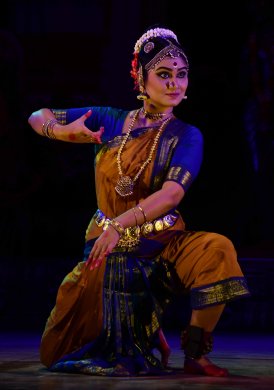 Mandakranta Roy Dr. Mandakranta Roy, currently further studying Bharatanatyam under C.V. Chandrashekhar, hails from Tripura. With an attractive stage presence, she has mastered the technique of Bharatanatyam which shows strong influence of Kalakshetra bani. She presented kirtanam describing the dance of Lord Shiva, his various attributes, dancing in arresting poses, and showcasing the excellent diagonal lines of Bharatanatyam, Mandakranta impressed the audience with her flawless dancing. The display of powerful presence of Parashakti was incorporated in dance. Her nritta was chiseled with energy. The popular Purandara dasa pada Krishna ni begane baro in Yamankalyan raga dwells on mother Yashoda's love for child Krishna. Running after him, Yashoda tempts him offering butter and embraces him, decorates him with pitambar, peacock feather, places ankle bells on his feet and gives him a small flute. She is overwhelmed seeing his divine beauty. She plays blindman's bluff game with him. Seeing him eating earth, she gets annoyed but realizes that he is a divine child and is happy to have him with her. The feelings of motherly love, 'vatsalya' were enacted competently. Some touches like asking baby Krishna to give her a kiss, though lokadharmi looked enchanting. Here is a dancer who has shown promise to master the form revealing its beauty. Guru Pankaj Charan Das is well known for his choreography of Pancha Kanya. Therefore it was appropriate that his son Sarat Das has with his memory redesigned and made it available for dancers to perform. Out of five parts, Sarat Das told me that he has music for all but Tara. Unfortunately, Ritha Devi, who used to perform all the five Kanyas, has recently passed away in Pune, and one does not know where the recordings are, as her son Rahul who looked after her in Pune has also passed away. Other dancer is Ratna Roy at Evergreen College near west Washington in USA, who has perhaps some music of this choreographic work. Guruji had taught some characters of the five Kanyas to Yamini Krishnamurty and Sumathi Kaushal. Sumathy is in California and when I last met her two years ago, she had told me that she has old recordings with her. Dance critic Shyamhari Chakra was given senior fellowship for completing the biography and works of Guru Pankaj Charan Das by the Ministry of Culture, Govt of India. I do not know if Shyamhari Chakra has completed the work. One hopes that scholars like him would bring out authentic material and make it available to interested people. Amrita Das based in Burdwan, is a disciple of Guru Kelucharan Mohapatra and has further studied in Srjan under Ratikant Mohapatra. Sarat Das taught her Draupadi's choreography with the music which is available. Sarat Das often visits Burdwan to teach some of the items he knows. Amrita has commanding stage presence and in the role of royal princess Drupad kanya, she did justice to Guru Pankaj's choreography and brought alive the character of Draupadi. Since we all know that Guru Pankaj Charan Das was also a gifted stage actor and director, his treatment of Draupadi is full of high drama. With her stately presence Amrita acted well when describing her own self as a royal princess.The game of dice, Shakuni's attahasya, laughter at Yudhisthira losing the game and placing in pawn his five brothers and finally Draupadi were narrated and enacted dramatically. Draupadi when being pulled by hair is brought in the court, her plea to her five husbands to protect her, praying to Bhishma as elder to protect her from Dushassana's advances, attempts at disrobing her and her utter helplessness were performed competently. Draupadi prays to Krishna, her friend, (also because of her friendship she is called his sister), to come to her succor and save her from humiliation. Krishna saves her. Dushassana falls exhausted on the floor pulling yards and yards of sari and Draupadi is saved from humiliation. The entire episode is riveting and even when known because of Draupadi's predicament, which is also that of women in present times, resonating contemporary similar issues of rape of women, this mythological story's appeal is universal. At times one finds that Guruji has used more drama and abhinaya of Draupadi verging on overacting, Amrita following Guruji's original choreography managed to keep up Guruji's intent and performed the role successfully. As a tribute to Guruji and his memory, the presentation was in its place. The musicians rose to the occasion and gave her excellent support.
Durga Charan Ranbir said that he was a student at Utkal Sangeet Mahavidylaya where both Guru Pankaj Charan Das and Guru Debaprasad Das were training the students. Several students used to request Pankaj Charan Das to choreograph small items for them for their spare time. Sarat Das told me that Guruji used to oblige. He had selected Bilvamangal's Balagopalashtakam for choreography. Durga Charan Ranbir had danced in it and also choreographed some movements. To pay tribute to Guruji it was decided to revive Balagopalashtakam as group dance. The childhood pranks of Krishna forms the major theme. Four male dancers and four female dancers with Guru Durga Charan Ranbir's guidance recreated Balagopalashtakam. All performed with vigour and there were excellent groupings. Durga Charan is known for his group choreography. The images of the lord riding over the vehicles, like Garuda and chariot were created graphically as tableau. The sequence of makhan chori, stealing the butter when the four gopis after churning, collecting the butter, placing them high up along with milk pots, go for fetching water. The gang of cowherd boys stealthily enters the home and looks all over for butter and milk. Finding them high up on the walls, not within their reach, they make pyramidal forms riding one over the other to get hold of the vessels in which butter is kept. They fall down, get up again and finally succeed in getting what they were searching for. After the usual fight they share butter, least realizing that from behind, the four gopis with sticks in their hands enter to punish them for their mischief and pranks. The entire episode is full of mirth and when Krishna starts crying, the Gopis are overcome with love for the naughty child and pamper him. The others watch with joy and the poet sings praise of Balagopala. Durga Charan Ranbir excels in his group choreography. The semicircular arrangement filling the stage looked attractive. The steps and movements were in perfect synch. The recorded music was captivating and the level of dancing was praiseworthy. Silver Jubilee of Guru Pankaj Charan Das Utsav and Centenary celebrations of Pankaj Charan Das: Part II  Dr. Sunil Kothari is a dance historian, scholar, author and critic, Padma Shri awardee and fellow, Sangeet Natak Akademi. Dance Critics' Association, New York, has honoured him with Lifetime Achievement award. Post your comments Please provide your name and email id when you use the Anonymous profile in the blog to post a comment. All appropriate comments posted with name & email id in the blog will also be featured in the site. |